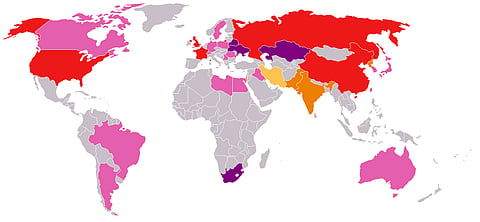

Nuclear disarmament has been a fundamental objective of the United Nations since its inception. The idea of eliminating nuclear weapons enjoys broad global support and has been a legally binding commitment under the Treaty on the Non-Proliferation of Nuclear Weapons (NPT) for over half a century. Despite this, little consensus exists on the motivations behind nuclear disarmament or the practical steps required to achieve it. Scholars have long debated the political dynamics of relinquishing nuclear arsenals, with some arguing that there is no clear theoretical framework to guide the process.
Perspectives on disarmament vary widely. Some experts believe it is primarily a technical challenge that can be resolved with sufficient time and resources. Others see it as a matter requiring steadfast advocacy to shift international norms. A third viewpoint suggests that direct confrontation with nuclear-armed states is counterproductive and that proponents of disarmament should seek to “engage, not enrage” resistant nuclear powers. The question remains: How can a coherent theory of nuclear disarmament be developed and evaluated? Understanding disarmament is also crucial for assessing the future of the NPT.
The academic community's limited focus on the causes of nuclear renunciation may stem from a lack of clear historical examples. Few states have voluntarily given up nuclear weapons, leaving analysts with minimal empirical data. However, theoretical frameworks have been developed in other areas of security studies, even in cases where direct evidence is scarce. Another reason for scholarly neglect may be the widespread belief that nuclear disarmament is either impossible or secondary to other security concerns. Some argue that nuclear weapons cannot be "disinvented" and that the prevailing conditions of global anarchy make disarmament an unrealistic goal. As one scholar puts it, disarmament is seen as “so obviously flawed that except for propaganda purposes, and for limited reductions in the context of arms control, the idea is a non-starter.”
Nonetheless, nuclear weapons are more than just tools of national security; they serve as powerful symbols in domestic politics, bureaucratic struggles, and international identity. Many nuclear-armed states have found it difficult to relinquish their arsenals, even when the threats that initially justified their acquisition have diminished. For instance, France and the United Kingdom maintain nuclear stockpiles despite facing less severe security challenges than many non-nuclear states. What factors, then, might prompt nuclear-armed states to disarm? And how should competing explanations for disarmament be evaluated?
The post-Cold War experience of former Soviet republics offers valuable insights into nuclear disarmament. Belarus, Kazakhstan, and Ukraine inherited nuclear weapons following the Soviet Union's dissolution but ultimately chose to relinquish them. Their decisions were made under ambiguous and potentially hostile security conditions, as Russia armed with most of the former Soviet Union's military power emerged as the dominant regional force. Border conflicts and revanchist ambitions in Moscow appeared real possibilities for these newly independent states.
Unlike Russia, which retained its nuclear arsenal as the legal, political, and cultural successor to the Soviet Union, these three nations did not have the full infrastructure to maintain nuclear capabilities independently. Their nuclear inheritance lacked the institutional backing of a long-established weapons program, which played a role in their decision to disarm. In contrast to South Africa, which developed its own nuclear weapons but never integrated them into public discourse, Belarus, Kazakhstan, and Ukraine were part of a Soviet state that had long portrayed nuclear weapons as central to national security. Militarism and the utility of nuclear weapons were deeply embedded in Soviet public life, with “military-patriotic education” promoted through schools, factories, and mass media.
Ukraine, in particular, had a highly nuclearized defense infrastructure. The country was home to a large pool of nuclear scientists, major Soviet missile manufacturers such as Yuzhmash and Khartron, and two of the Soviet Union’s largest nuclear forces: the 43rd Strategic Rocket Army and the 46th Air Army. Despite this, Ukraine relinquished its nuclear weapons, highlighting the complexity of disarmament decisions. One of the most commonly cited lessons from nuclear arms reduction efforts comes from U.S.–Soviet and U.S.–Russian arms control negotiations. Many policymakers equate arms control with disarmament, arguing that incremental reductions will eventually lead to complete elimination. However, history suggests that arms control has often coexisted with robust nuclear programs, with military-industrial stakeholders continuing to thrive despite reductions in stockpile sizes.
While certain material stakeholders resist all nuclear restrictions, many public and commercial entities involved in the nuclear enterprise have supported arms control. Incrementalist arms control has historically been linked to deterrence theory and the functioning of the military-industrial complex rather than being opposed to it. Since the unit cost of weapons and defense equipment tends to rise with each new generation, vested interests in the nuclear sector have continued to prosper even as overall stockpile sizes have decreased since the 1980s.
At the same time, reducing the overall size of a nuclear arsenal diminishes the economic and political significance of the vested interests that depend on nuclear weapons programs. Arms control might, therefore, have indirect benefits for disarmament by weakening the influence of those who oppose relinquishment. However, a complete path to nuclear disarmament will likely require more than just arms control—it will necessitate addressing the deep-seated political, strategic, and economic factors that sustain nuclear arsenals.